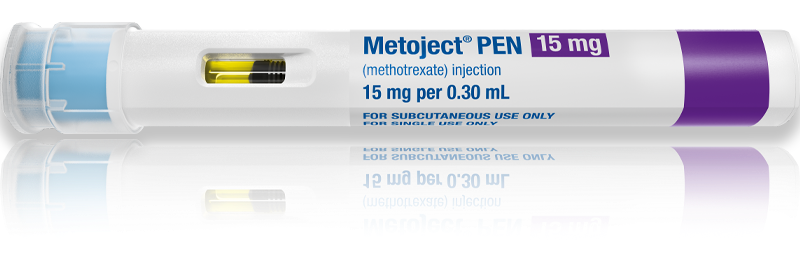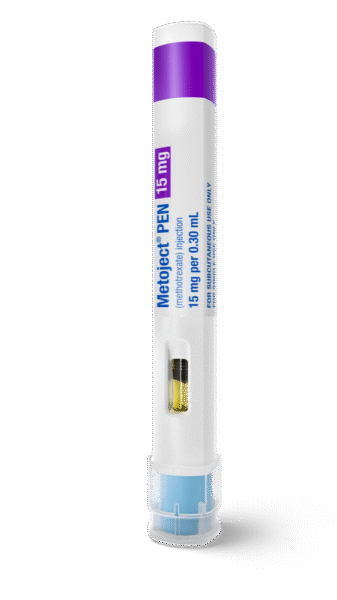Once weekly injection
This webpage is intended for UK healthcare professionals. If you are not a healthcare professional, please click here.
Introducing the button-free Metoject® PEN

Offering the simplicity of a button-free autoinjector, purpose designed with patient-friendly features
About Metoject® PEN
Metoject® PEN is a once a week pre-filled methotrexate auto-injector, indicated for treatment of rheumatoid arthritis, juvenile idiopathic arthritis, psoriatic arthritis, psoriasis and Crohn’s disease.1

Metoject® PEN is available in 10 colour coded doses

Metoject® PEN Key Facts1,5,6
Administering Metoject® PEN
The following video explains the Metoject® PEN self injection process.
Metoject® PEN requires you to be aware of the proper injection technique.
Patients must be educated and trained in the proper injection technique when self-administering methotrexate.
Benefits of Metoject® PEN Compared to Oral Administration
 The bioavailability of subcutaneous methotrexate is higher compared to oral methotrexate.1,3
The bioavailability of subcutaneous methotrexate is higher compared to oral methotrexate.1,3In dosages between 7.5mg/m2 and 80mg/m2 body surface area, the bioavailability of subcutaneous methotrexate is nearly 100%, while the mean bioavailability of methotrexate absorbed from the gastrointestinal tract is approx. 70% with considerable inter- and intra-individual deviations.
Subcutaneous administration of methotrexate with Metoject® PEN resulted in a higher relative bioavailability compared to oral administration of methotrexate after single doses of 7.5mg, 15mg, 22.5mg, and 30mg.

Subcutaneous administration is significantly more effective than oral administration.7
A study compared the efficacy of subcutaneous vs. oral methotrexate in patients with active rheumatoid arthritis. At week 24, significantly more patients treated with subcutaneous methotrexate than with oral methotrexate met the American College of Rheumatology (ACR) criteria for 20% improvement (78% versus 70%) and ACR criteria for 70% improvement (41% versus 33%).Patients with a disease duration ≥ 12 months had even higher response rates for the ACR criteria for 20% improvement (89% versus 63%).
The rate of adverse events was similar in all groups.

Patients suffer less frequent and less intense GI discomfort with subcutaneous administration.4
A survey compared the frequency and intensity of nausea and frequency of gastrointestinal discomfort in rheumatoid arthritis patients treated with either oral or subcutaneous methotrexate. The results demonstrated that changing methotrexate dosing from oral to subcutaneous significantly reduced gastrointestinal adverse events.
Further Support Materials
Please use the following buttons to download Metoject® PEN SPC, ordering information, and prescribing information.
Treatment Categories
Please select the relevant link below for Metoject® PEN usage information for dermatology or rheumatology.
Reporting Side Effects
Adverse events should be reported using the forms and information found at yellowcard.mhra.gov.uk
Please also report any adverse events by email to medac drug safety at drugsafety@medac.de
Further Information & Questions
Visit our contact page to submit an enquiryReferences:
- Metoject® Summary of Product Characteristics. [online] Available at: https://www.medicines.org.uk/emc/search?q=metoject#gref/. Last Accessed May 2023
- Müller, R.B. et al. (2015). Effectiveness, tolerability, and safety of subcutaneous methotrexate in early rheumatoid arthritis: A retrospective analysis of real-world data from the St. Gallen cohort. Seminars in Arthritis and Rheumatism, 45(1), pp.28–34.
- Pichlmeier, U., & Heuer, K. U. (2014). Subcutaneous administration of methotrexate with a prefilled autoinjector pen results in a higher relative bioavailability compared with oral administration of methotrexate. Clinical and experimental rheumatology, 32(4), 563–571.
- Kromann, C.B. et al. (2014). Does switching from oral to subcutaneous administration of methotrexate influence on patient reported gastro-intestinal adverse effects? Journal of Dermatological Treatment, 26(2), pp.188–190.
- EU Council Directive 2010/32/EU on the prevention of sharps injuries in the hospital and healthcare sector
- Latex data on file
- Braun, J. et al. (2008). Comparison of the clinical efficacy and safety of subcutaneous versus oral administration of methotrexate in patients with active rheumatoid arthritis: results of a six-month, multicenter, randomized, double-blind, controlled, phase IV trial. Arthritis and rheumatism, 58(1), 73–81.
- Methotrexate and its use in rheumatoid arthritis (RA). [online] Available at: https://nras.org.uk/resource/methotrexate/. Last Accessed May 2023.
- Johnson, T.M. et al. (2021). Investigating changes in disease activity as a mediator of cardiovascular risk reduction with methotrexate use in rheumatoid arthritis. Annals of the Rheumatic Diseases, [online] 80(11), pp.1385–1392.
- O’Connor, A. et al. (2016). The rapid kinetics of optimal treatment with subcutaneous methotrexate in early inflammatory arthritis: an observational study. BMC Musculoskeletal Disorders, 17(1).
- Kanwar, A., Yadav, S. and Dogra, S. (2010). Psoriasis: What is new in nonbiologic systemic therapy in the era of biologics? Indian Journal of Dermatology, Venereology, and Leprology, 76(6), p.622.
- Warren, R.B. et al. (2017). An intensified dosing schedule of subcutaneous methotrexate in patients with moderate to severe plaque-type psoriasis (METOP): a 52 week, multicentre, randomised, double-blind, placebo-controlled, phase 3 trial. The Lancet, 389(10068), pp.528–537.
- Reich, K. et al. (2020). The value of subcutaneous vs. oral methotrexate: real‐world data from the German psoriasis registry PsoBest. British Journal of Dermatology, 184(4), pp.765–767.
- Generali, E. et al. (2021). Non-adherence and discontinuation rate for oral and parenteral methotrexate: A retrospective-cohort study in 8,952 patients with psoriatic arthritis. Journal of Translational Autoimmunity, 4, p.100113.